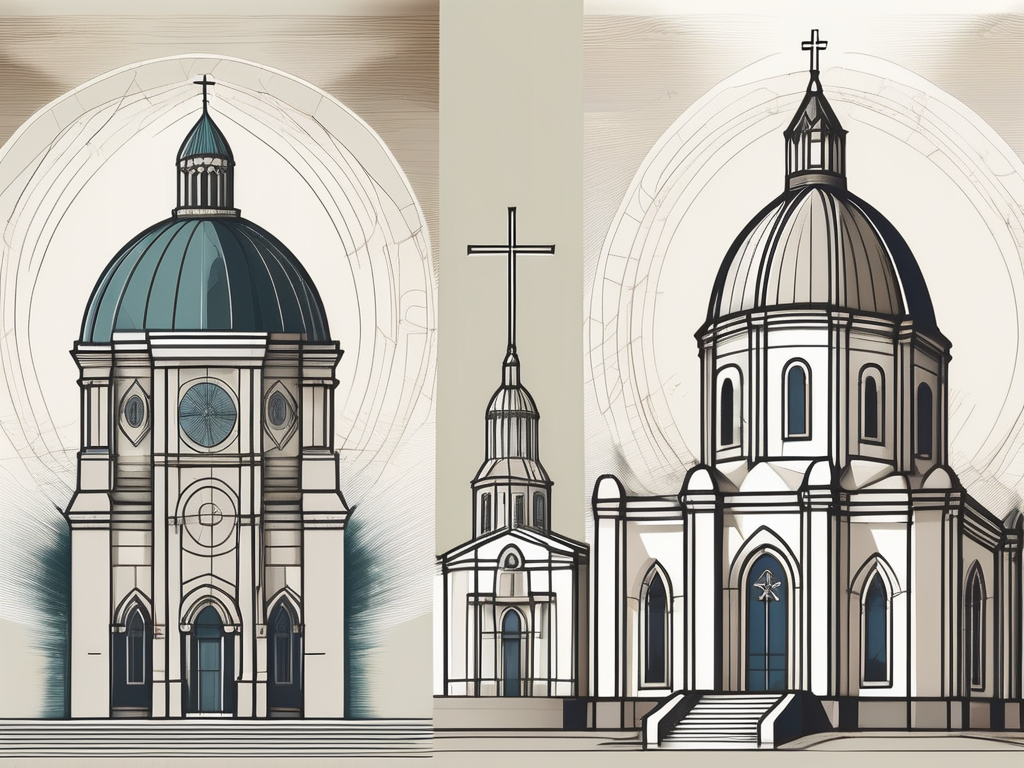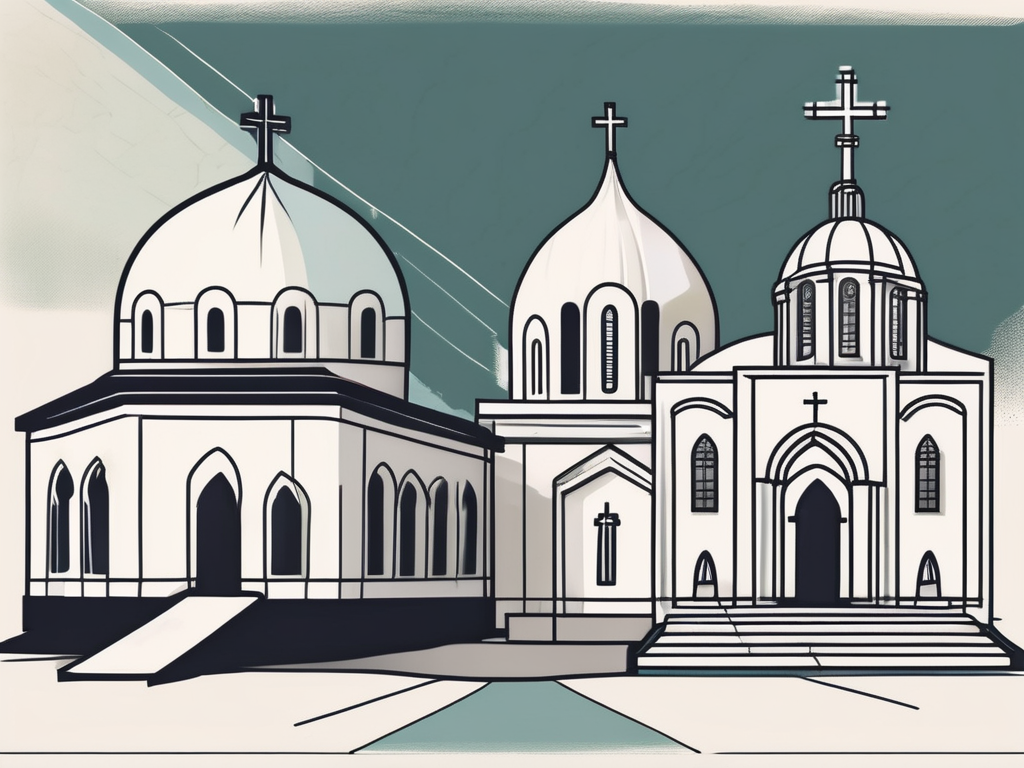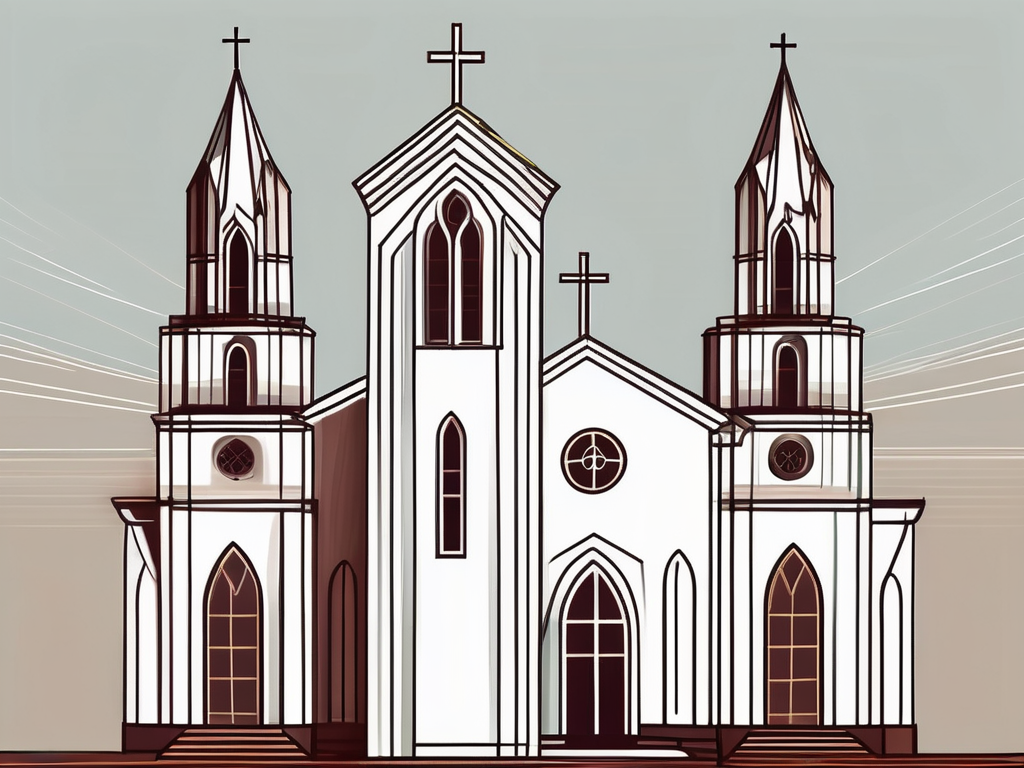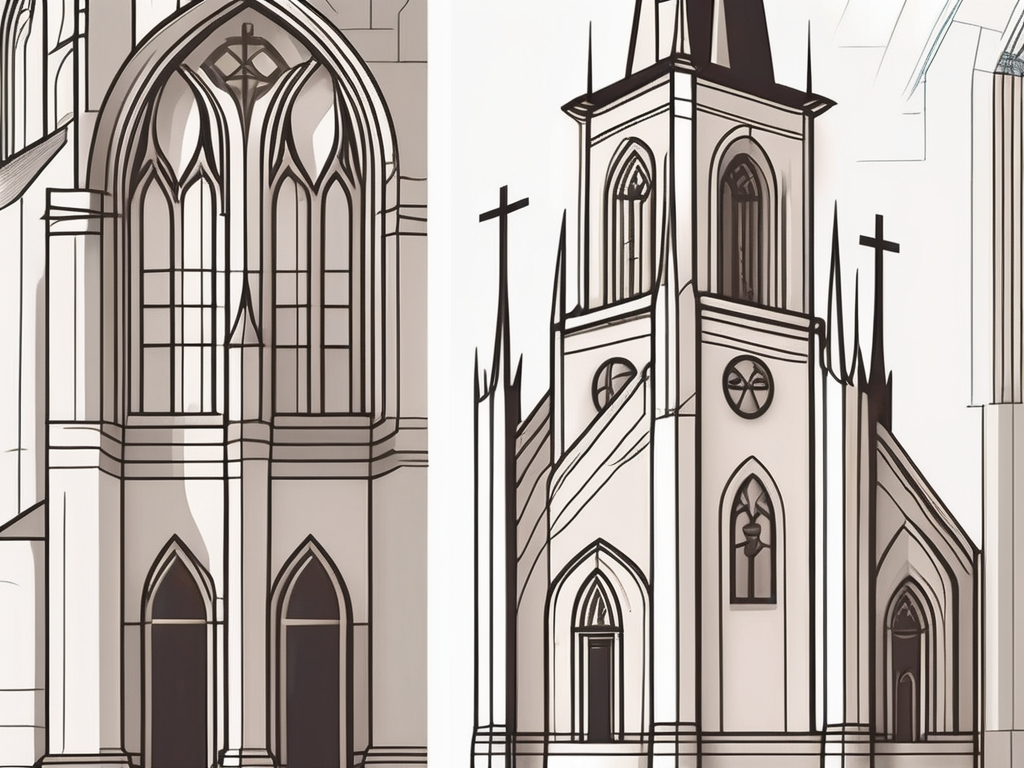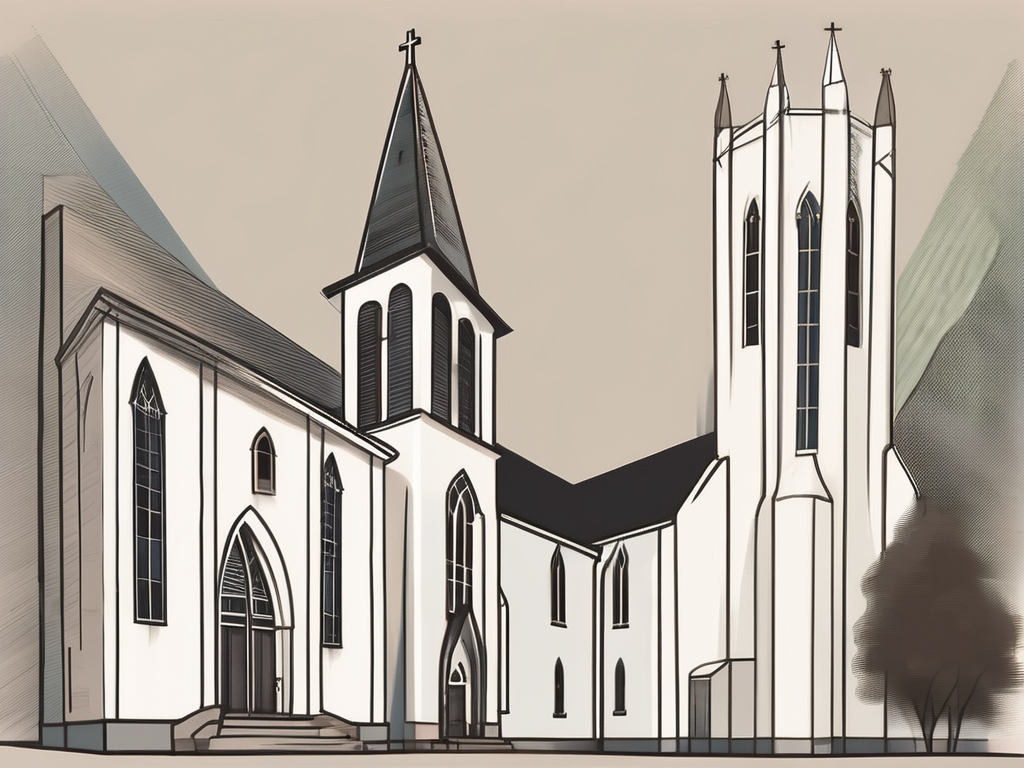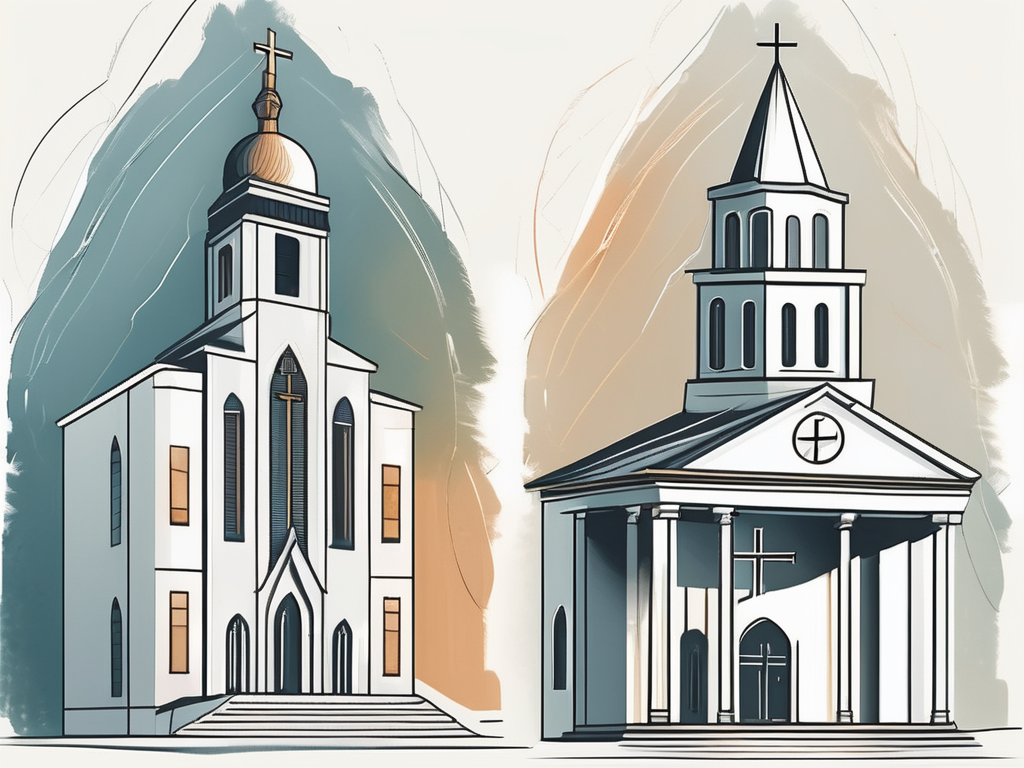When it comes to religion, there are countless denominations and faiths to choose from. Two of the most prominent ones are Catholicism and Baptism. While they share some Christian beliefs, there are also distinct differences in their practices and traditions. In this article, we’ll explore the basics of Catholicism and Baptism, delve into their historical backgrounds, examine their core beliefs and doctrines, discuss their worship rituals, explore the roles of the Church and clergy, and finally, take a look at their perspectives on salvation and the afterlife.
Understanding the Basics: Catholicism and Baptism
Before comparing Catholicism and Baptism, it’s important to have a solid understanding of what each entails.
Origins and Historical Background of Catholicism
Catholicism traces its roots back to the teachings of Jesus Christ and the Apostles. It is the oldest Christian denomination and claims a direct lineage to the early Church founded by Jesus himself. Over the centuries, Catholicism has become a rich and intricate tapestry of beliefs, rituals, and traditions.
From the grandeur of St. Peter’s Basilica in Vatican City to the humble parish churches scattered throughout the world, Catholicism has truly global reach. Its hierarchy, led by the Pope, is organized into dioceses and parishes, with priests, deacons, and bishops serving the spiritual needs of the faithful.
The Catholic Church places great importance on the sacraments, which are considered visible signs of God’s grace. These sacraments include baptism, confirmation, Eucharist, reconciliation, anointing of the sick, holy orders, and matrimony. Each sacrament holds a special significance in the life of a Catholic, marking important milestones and providing spiritual nourishment.
The celebration of Mass, the central act of worship in Catholicism, is a solemn and sacred event. It involves the consecration of bread and wine, which Catholics believe become the body and blood of Jesus Christ. The Mass is a time for prayer, reflection, and communion with God and the community of believers.
Origins and Historical Background of Baptism
Unlike Catholicism, which can be traced back to the time of Jesus and the Apostles, Baptism has a more recent origin. The Baptist movement emerged during the Protestant Reformation in the 16th century. Baptists emphasize the importance of personal faith and individual choice in accepting Jesus Christ as Savior.
Baptist churches, often characterized by their focus on adult baptism by immersion, gained popularity across the world during the revival movements of the 18th and 19th centuries. Baptists have a congregationalist structure, meaning that each local church is autonomous and governs its own affairs.
In addition to adult baptism, some Baptist churches also practice infant baptism, viewing it as a dedication of the child to God and a commitment by the parents to raise the child in a Christian environment. However, the emphasis on personal faith and choice means that baptism is ultimately seen as a public declaration of one’s personal relationship with Jesus Christ.
Baptist worship services are often characterized by lively singing, heartfelt prayers, and engaging sermons. The congregation plays an active role in the service, with members encouraged to participate and share their faith experiences. Baptists believe in the priesthood of all believers, meaning that every member of the church has a direct relationship with God and can serve as a minister of the Gospel.
While Catholicism and Baptism have different historical origins and theological emphases, both hold baptism as a central sacrament. Whether it is the sacrament of initiation into the Catholic Church or the public declaration of faith in Baptist churches, baptism represents a significant milestone in the spiritual journey of believers.
Core Beliefs and Doctrines
Both Catholicism and Baptism follow the teachings of Jesus Christ and regard the Bible as the inspired Word of God. However, there are significant differences in their core beliefs and doctrines.
Fundamental Teachings of Catholicism
Catholicism places great emphasis on the sacraments, particularly the Eucharist, which is believed to be the actual body and blood of Jesus Christ. The Catholic Church also affirms the authority of the Pope, as the successor of St. Peter, and the importance of tradition in interpreting Scripture.
Furthermore, Catholicism holds the belief in the concept of purgatory, a state of purification after death, where souls are cleansed before entering heaven. This belief is based on the idea that not all sins are mortal and that some sins can be forgiven through prayers and acts of penance.
In addition to purgatory, the Catholic Church practices prayers for the deceased, believing that these prayers can help the souls in purgatory to move closer to God and eventually attain salvation. This practice is rooted in the belief in the communion of saints, where the faithful on earth can intercede for the souls in purgatory.
The veneration of saints is another distinct belief of Catholicism. Catholics believe that saints, who are holy men and women who have lived exemplary lives, can intercede with God on behalf of the faithful. They seek the intercession of saints through prayers and the use of religious objects, such as statues and relics.
Additionally, the Catholic Church acknowledges the role of Mary, the mother of Jesus, as a spiritual intercessor and holds her in high regard. Mary is considered the Mother of God and is honored with titles such as “Mother of the Church” and “Queen of Heaven.” Catholics believe that Mary’s intercession can bring them closer to Jesus and help them on their spiritual journey.
Fundamental Teachings of Baptism
Baptists place strong emphasis on the individual’s personal relationship with Jesus Christ. They believe in salvation through faith alone, rejecting the need for sacraments or religious rituals. Baptists also stress the autonomy of the local church and the priesthood of all believers.
Unlike Catholicism, Baptists do not venerate saints or pray to the deceased. They regard the Bible as the sole authority in matters of faith and practice, and each individual is responsible for interpreting Scripture for themselves.
Baptists believe in the concept of believer’s baptism, which means that baptism is only valid for those who have made a personal profession of faith in Jesus Christ. They practice baptism by immersion, symbolizing the believer’s identification with the death, burial, and resurrection of Jesus Christ.
Furthermore, Baptists emphasize the importance of evangelism and the spreading of the Gospel. They believe that it is the responsibility of every believer to share their faith with others and bring them to a personal relationship with Jesus Christ.
In terms of church governance, Baptists advocate for congregationalism, where decisions are made by the local church members through voting. This stands in contrast to the hierarchical structure of the Catholic Church, where decisions are made by the Pope and the hierarchy of bishops.
Overall, while both Catholicism and Baptism share a common foundation in the teachings of Jesus Christ and the inspiration of the Bible, their core beliefs and doctrines diverge significantly in areas such as sacraments, authority, intercession, and church governance.
Worship and Rituals
Worship practices differ between Catholicism and Baptist traditions, reflecting their distinct beliefs and approaches to spirituality.
When it comes to Catholic worship practices, there is a strong emphasis on the celebration of the Eucharist, also known as Mass. This sacred ritual is viewed as a reenactment of Christ’s sacrifice on the cross, and it holds a central place in Catholic worship. The Mass is not just a simple gathering; it is a profound and deeply meaningful experience for Catholics around the world.
During the Mass, various liturgical elements come together to create a rich and vibrant worship experience. The prayers, readings from the Bible, and sacraments all play integral roles in the Catholic worship tradition. These elements are carefully chosen and structured to guide the faithful through a journey of spiritual reflection and communion with God.
One of the distinguishing features of Catholic worship is the use of elaborate rituals. Processions, incense, and sacred music are all part of the tapestry that makes up a Catholic Mass. The processions, often led by the clergy, create a sense of reverence and awe as the faithful witness the symbols of their faith being carried through the church. The use of incense adds a sensory element to the worship experience, filling the air with a sweet and fragrant aroma that symbolizes the prayers of the faithful rising to heaven. And of course, sacred music, whether it be traditional hymns or choral compositions, fills the sacred space, lifting hearts and minds to God.
Furthermore, Catholic churches are known for their ornate artwork and icons. These visual representations of saints, biblical scenes, and religious symbols serve as aids to devotion, inviting the faithful to contemplate and connect with the divine. The intricate details and vibrant colors of these artworks create a sense of beauty and transcendence, inspiring a deeper sense of reverence and awe in the presence of God.
On the other hand, Baptist worship practices take on a simpler and more informal approach. Baptist churches prioritize congregational singing, heartfelt prayers, and the preaching of the Word. The belief that all believers have direct access to God shapes the way Baptists approach worship, with less emphasis on liturgical rituals or sacraments.
When attending a Baptist worship service, you can expect to find a strong sense of community. Baptist churches often foster an environment that encourages active participation from all members. The congregation is seen as a family, and everyone is invited to contribute their talents and gifts to the worship experience. This sense of community extends beyond the walls of the church, with many Baptist congregations engaging in various outreach and service projects to make a positive impact in their communities.
Music also plays a significant role in Baptist worship. Hymns, with their rich theological lyrics, are sung with great enthusiasm and reverence. These timeless songs connect the congregation to the rich history of their faith and provide a means for expressing their devotion to God. In addition to traditional hymns, contemporary praise songs have found a place in Baptist worship, offering a more modern expression of faith and worship.
While Catholic and Baptist worship practices may differ in their rituals and approach, both traditions seek to create spaces where believers can encounter the divine and grow in their relationship with God. Whether it be through the solemnity and grandeur of a Catholic Mass or the heartfelt simplicity of a Baptist worship service, the ultimate goal is to offer worship that is pleasing to God and nourishing to the souls of the faithful.
The Role of the Church and Clergy
The structure and role of the Church, as well as the clergy, vary between Catholicism and Baptism.
The Catholic Church and Its Clergy
In Catholicism, the Church hierarchy is headed by the Pope, who is regarded as the Vicar of Christ on Earth. He is assisted by bishops and priests, who administer the sacraments and provide spiritual guidance to the faithful. Priests play a central role in celebrating Mass and hearing confessions.
The Catholic Church embraces the concept of apostolic succession, which means that the authority and power of the Apostles have been passed down through generations of clergy.
The Baptist Church and Its Clergy
Baptist churches operate on a congregational model, whereby each local church governs its own affairs and selects its leaders. The clergy in Baptist churches, which may include pastors, ministers, and deacons, are chosen by the congregation. They are responsible for preaching, teaching, and pastoral care.
Baptists do not believe in apostolic succession or the infallibility of clergy. Instead, they emphasize the priesthood of all believers, affirming that each individual can approach God directly without the need for intermediaries.
Views on Salvation and Afterlife
The perspectives of Catholicism and Baptism on salvation and the afterlife differ in certain key aspects.
Catholic Perspective on Salvation and Afterlife
Catholics believe in salvation through faith and good works. They regard baptism as a sacrament that cleanses a person from original sin and initiates them into the community of believers. Catholics also place importance on the process of ongoing sanctification throughout one’s life.
Catholic theology teaches the possibility of salvation for those who sincerely seek God, even if they are not formal members of the Catholic Church. They also uphold the belief in purgatory, a place of purification after death, where souls are prepared for their ultimate union with God in heaven.
Baptist Perspective on Salvation and Afterlife
Baptists, in contrast, emphasize salvation through personal faith in Jesus Christ. They believe that individuals must make a conscious decision to accept Jesus as their Lord and Savior to attain salvation. They do not view baptism as necessary for salvation but consider it an outward expression of an inward change.
According to Baptist theology, after death, believers go directly to be with God in heaven, while those who reject Christ face eternal separation from God in hell.
Conclusion
Although Catholicism and Baptism share their foundation in Jesus Christ and Christian beliefs, they diverge in many aspects. Catholicism has its rich historical traditions, its hierarchical structure, and its emphasis on sacraments and the intercession of saints, while Baptism reflects a more individualistic and congregational approach to faith. The worship practices, the role of the Church and clergy, and the perspectives on salvation and the afterlife showcase the differences between these two influential faiths. By exploring these differences, we gain a deeper understanding of their distinctive beliefs and practices, encouraging us to embrace diversity and engage in respectful conversations about faith and spirituality.
